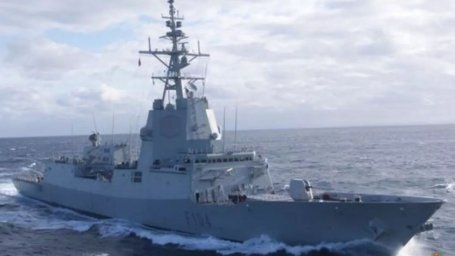Operation Noble Shield
The Russian threat is monitored 24 hours a day by NATO through its missions. One of them is Operation Noble Shield, in which the frigate Méndez Núñez, integrated into the permanent NATO group, is actively participating.
It was converted into a command ship due to the breakdown suffered by the British ship and forced the commander of the NATO Permanent Naval Group No. 2, Paul Stroude, to board the Spanish frigate.
The commander, David Díaz-Caneja, revealed during a videoconference with the Minister of Defense, Margarita Robles, that since they embarked on the NATO mission in Souda, the Greek island of Crete, they have interacted with five Russian ships, without that a tense situation would develop since they manage an established security protocol to «not enter into a situation of misunderstanding.»
In addition, it has confirmed a «decrease in the activity of the Russian navy in Mediterranean waters» and that there is still movement «especially of spy units» that help the Russian Navy and warships that operate in the area. These missions are essential to obtain intelligence information, such as obtaining Russian behavior at sea and tracking its movements.
The Spanish Navy intercepts five Russian ships in the waters of the eastern Mediterranean
The frigate Méndez Núñez, converted into a NATO command ship, has seen a decrease in the activity of the Russian navy
NATO maintains active surveillance and deterrence not only by air, but also by sea. The latent threat from Russia is being monitored 24 hours a day by the Atlantic Alliance, through its different missions.
One of them is the Noble Shield operation in which the frigate Méndez Núñez model F100, integrated into the permanent group of NATO, actively participates, and which has become the command ship, following the breakdown it has suffered. the United Kingdom warship, which has forced the commander of the NATO Standing Naval Group No. 2 (SNMG-2), British Royal Navy Commodore Paul Stroude, to board the Spanish frigate to take over mission control from the frigate Méndez Núñez.
The commander of the frigate Méndez Núñez, David Díaz-Caneja, has revealed that since they embarked on the NATO mission, heading to Souda, on the Greek island of Crete, they have interacted with five Russian ships. In the interactions with these Russian navy ships there has not been any situation of tension because the NATO mission commanders manage an established security protocol to «not enter into a situation of misunderstanding» and avoid any situation of violent escalation.
Constant movement of «spy units»
During the videoconference he held with the acting Minister of Defense, Margarita Robles, the commander of the frigate Méndez Núñez also confirmed that they have observed a “decrease in the activity of the Russian navy in Mediterranean waters”, the explanation “may be due to a transfer of units in other areas of the Mediterranean.” Even so, it is confirmed that there continues to be movement “especially of spy units” that support the Russian Navy and also warships that continue to operate in the area.
For NATO, these interactions are vital to obtain intelligence information, in particular, to obtain a pattern of the behavior of the Russian navy and track its movements.
The Spanish Navy detects Russian vessels in the Mediterranean
The frigate Méndez Núñez has reported five «interactions» with Russian ships in transit to and from Souda, on the Greek island of Crete
The Spanish Navy frigate Méndez Núñez has reported five interactions with Russian vessels in Mediterranean waters within the patrol entrusted as a NATO command ship. Furthermore, its monitoring work has confirmed a decrease in the activity of the Russian navy in this area, apart from «an unexpected movement in recent times.»
This was reported by the commander of the frigate Méndez Núñez, David Díaz-Caneja, in a video conference with the acting Minister of Defense, Margarita Robles, in which he reviewed the «intelligence gathering» work led by the Spanish vessel after set sail on August 18 from the Ferrol Military Arsenal.
«What can be seen in the Mediterranean area is a decrease in the activity of the Russian navy. It may be a transfer of units from the northern European area to the Mediterranean area. Currently it has decreased, but there has been a unexpected movement in recent times,» the commander indicated.
Regarding the five «interactions» with Russian ships, he has indicated that they have occurred in transit to and from Souda, on the Greek island of Crete, and that NATO protocols have been complied with at all times to avoid any «misunderstanding.» «with the Russian navy.
»There has not been any situation that has given us to understand any type of escalation or increase in their enlistment in our presence," added the commander, who participates in the NATO mission in the context of maritime surveillance for the war. from Ukraine.
Among the new developments, the commander has said that no interactions have been established with Russian aircraft, pointing out that this is because «possibly» they are not currently concentrating on the Syrian channel, although without ruling it out in the future.
He has also reported on the situation after providing help for the breakdown suffered by a United Kingdom warship, which has forced the commander in command, British Royal Navy Commodore Paul Stroude, to board the Spanish frigate to assume control of the mission from the 'Méndez Núñez'.
In her videoconference, Margarita Robles also reviewed the situation of the frigate Navarra, in another mission in charge of patrolling against piracy within Operation Atalanta and protecting food ships for countries like Somalia and Yemen, hit by serious internal crises.
